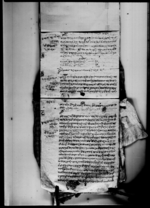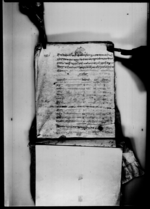A copy of a lālamohara from King Rajendra restoring to Amṛtānanda and Sundarānanda their ancestral right to overseership of the Luthāma Guṭha and its land endowments (VS 1884)
ID: K_0014_0014C
Edited and
translated by Manik Bajracarya
in collaboration with
Rabi Acharya
Created: 2020-08-27;
Last modified: 2023-07-23
For the metadata of the document, click here
The accompanying edition, translation/synopsis and/or commentary are available under the terms of the Creative Commons Attribution-ShareAlike 4.0 International License
Abstract
The lālamohara of King Rājendra of which this is a copy gives back to Amṛtānanda and Sundarānanda the Luthāma Guthi founded by their forefather in support of the vimāna offered to the chariot of Matsyendranātha. It records 50¾ ropanis of land belonging to the guthi.Diplomatic edition
[165]
1१६५नं1२२४नं1पो१६।पा∙११सी∙५३1मछीन्द्रको2गुठि1भं∙नौहर्ष
2हे∙नौ∙राम1आगेसहरपाटंकोकुवहालमहावुःधघरकोअमृतानंदसुन्दरानन्द
2वाडाकेतेरापुर्षाजीवराजवाडालेश्रीमछीन्द्रनाथकारथमासुनकोवी
3मानचढाउँदाराष्याकोगुठीपछीवीचमाईजारागरीमंगलभटवाट
4पजनीहुन्दोरहेछ५८सालमाभाजुधनजैसीलेथुंदागुठीईजारा
5हुदादेवताकोलुथानररथकावीमानसवैवीग्र्योईजारादारलेवना़येन
6भनीवींतीगर्दाईजारामेटीभाजुधनजैसीकानाउँमामोहरभ़याकोरहेछ
7सर्कारवाटईजारा∙मेटीवक्स्यापछीमेरापुर्षाकागुठी∙मैलेषानुपाऊन्या
8होभनी∙तीमीहरुकोवावारमानंदवाडालेश्री५वुवाज्यूकाहजुरमा
9वींतीगर्दाचौवीसहजारकाजानकारवुढावुढाहरूसीतजाचदातिमे
10हरूकापुर्षालेराष्याकोरहेछर६०सालमारमानंदवाडालाईमोहर
11गरीथामीवक्सनुभ़यकोरहेछरामानन्ददराहालकाजांचमापोता
12नतीर्याकोभनीजफतगर्दाफेरी:६२सालमामोहरगरीथामीवक्स
13नुभ़याकोरहेछ८३सालमाहाक्याकटु़वाललेरामानंदवाडाकानाउँ
14कोमोहरहानीआफ्नानाउँकोमोहरगराईलुथांगुठीमावहालीग
15र्दातीमीहेरूलेहाम्राहजुरमावींतीगर्दादफ्दरषाना∙श्रीकुमारीचोक
16वाटचढा⟪जचा⟫उँदाराजगुठीहोभन्यामानीसनठहर्दाहीजोकाजाचमारह्या
17कोजीउँतावुढावुढाहरूसीतसोधदाईनैवादाकापुर्षालेराष्याकोहोभं
18दासुनाथ्युंभंदाहीजोपनीश्री५वुवाज्यूवाटतीमीहेरूकावावुकोनाउँ
19मामोहरगरी[?]भयाकोरहेछआजहामीलेपनी∙तपसीलवमो[unknown seal]
[166]
[unknown seal]1१६६नं20जीं∙काषेतरोपनी∙५०।।। कोपोतारूपै़या२७।।सालवसालतीरीश्री
21मछीन्द्रनाथकारथ∙कासुनकोवीमानतोरनलुथांवीग्र्याकोसा
22लवसालवनाई∙परापुर्वदेषीचलीआ़याकोगुठी∙चलाईसेषर
23ह्याकोषानु∙भनीथामीवक्स्यौंआफ्नाषातीरज्मासीत∙पुर्षाकोगुठीजा
24नीभोग्यगर¯¯¯ ¯¯¯ ¯¯¯ ¯¯¯
25तपसील
[table]
| 1 | असामी¯¯¯¯¯¯ | षेतरोपनी | दर | रूपैया |
| 2 | ङषु¯¯¯¯¯¯ | ६ | ।। | ३ |
| 3 | पाको¯¯¯¯¯¯ | ६ | ।।। | ४।। |
| 4 | पतीपा¯¯¯¯¯¯ | ६ | ।।। | ४।। |
| 5 | भेलुपा¯¯¯¯¯¯ | ६ | ।।। | ४।। |
| 6 | लानीवु¯¯¯¯¯¯ | ७ | ।// | २।।// |
| 7 | कुसुंती¯¯¯¯¯¯ | ८ | ।। | ४ |
| 8 | थछे¯¯¯¯¯¯ | १ | । | । |
| 9 | ङषुवगर¯¯¯¯¯¯ | १ | । | । |
| 10 | लानीवु¯¯¯¯¯¯ | १।।। | ।। | ।।।// |
| 11 | धोपो¯¯¯¯¯¯ | ३ | ।// | १// |
| 12 | टेपना¯¯¯¯¯¯ | ५ | ।// | १।।।// |
38ईतीसम्वत१८८४सालवैसाषसुदी१५रोज६[?]¯¯¯¯¯¯
Translation
[165]
No. 1651
No. 2242
po. 16 pā. 11 sī. 533
[Document relating to] the guṭhī of Matsyendranātha (text: machīndra)
Āge: To Amṛtānanda Bāḍā and Sundarānanda Bāḍā, residents of Mahābuddha (text: Mahāvuḥdha), Oku Bāhāla in Patan. It is learnt that the guṭhī established by your ancestor Jīvarāja Bāḍā when he offered a golden vimāna to the chariot of glorious Matsyendranātha was later on placed under the ijārā [system], and [overseership of it] was assigned (pajanī) through the Maṅgalabhaṭa (the chief court of Patan). It is [also] learnt that in VS [18]58 Bhājudhana Jaisī hindered [further operations under that system] by making petition, saying: "Since the guṭhī has been placed under the ijārā [system], the luthāma (text: luthāna) of the deity and the vimāna of the chariot have broken, and the contractor (ijārādāra) has not repaired them." The ijārā [system on the part of the guṭhī] was [then] abolished and a mohara was issued in the name of Bhājudhana Jaisī.
[Then,] when your father Ramānanda Bā̃ḍā petitioned to [our] fivefold venerable father6 , saying: "Since Your Majesty has abolished the ijārā [system], I should be allowed to enjoy the guṭhī of my ancestors," and after enquiring with elders among the twenty-four thousand [households/people of Patan] and determining that [the guṭhī was indeed] established by your ancestors, he instated Rāmānanda [as the overseer of the guṭhī] in the year [VS 18]60 by issuing a mohara.
Upon an examination [conducted] by Rāmānanda Dahāla7 , [the guṭhī] was expropriated for failing to pay potā-levies, [but later our father] again instated [Ramānanda Bā̃ḍā as overseer] in the year [VS 18]62.
In the year [VS 18]83, when Hākyā Kaṭuvāla had the mohara of Rāmānanda Bā̃ḍā annulled and got another mohara issued in his own name to receive overseership of the Luthāma Guṭhī, [and] when you petitioned to us [to reverse this], we had [the matter] examined by the Daphdarakhānā and the venerable Kumārī Coka. They could not determine that anyone identified the [Luthāma] Guṭhī as a rājaguṭhī. Upon enquiring with the living elders who participated in the earlier examination8 , [we] were informed: "We have heard that [the guṭhī] was established by an ancestor of these very Bā̃ḍās." My fivefold venerable father had also issued a mohara in your father's name in the past.
[166]
No. 1669
Today we, too, have instated [you as overseers of the guṭhī], declaring: "You shall pay annually a potā-levy of 27 rupees 2 sukās for the plots, covering 50 ropanīs 3 javās as listed [below], repair the golden vimāna, toraṇa [and] luthāma (text: luthāṃ) of the chariot of glorious Matsyendranātha every year, [if] damaged, manage the guṭhī following the traditional custom and enjoy the surplus." Being mindful of your duty, enjoy [its fruits,] knowing that it is the guṭhi of your ancestors.
The list [of guṭhī lands and the tax on them]
[table]
| 1 | Column (asāmī) [of plot locations] | Plots [in] ropanīs | Rate | Rupees |
| 2 | Ṅakhu | 6 | 2 [sukās] | 3 [rupees] |
| 3 | Pāko | 6 | 3 [sukās] | 4 [rupees], 2 [sukās] |
| 4 | Patīpā | 6 | 3 [sukās] | 4 [rupees], 2 [sukās] |
| 5 | Bhelupā | 6 | 3 [sukās] | 4 [rupees], 2 [sukās] |
| 6 | Lānību | 7 | 1 [sukā], 2 [ānās] | 2 [rupees], 2 [sukās], 2 [ānās] |
| 7 | Kusuṃtī | 8 | 2 [sukās] | 4 [rupees] |
| 8 | Thache | 1 | 1 [sukā] | 1 [sukā] |
| 9 | Ṅakhu Bagara | 1 | 1 [sukā] | 1 [sukā] |
| 10 | Lānību | 1 [ropanī], 3 [javās] | 2 [sukās] | 3 [sukās], 2 [ānās] |
| 11 | Dhopo10 | 3 | 1 [sukā], 2 [ānās] | 1 [rupee], 2 [anās] |
| 12 | Ṭepanā | 5 | 1 [sukā], 2 [ānās] | 1 [rupee], 3 [sukās], 2 [ānās] |
Friday, the 15th of the bright fortnight of Vaisākha in the [Vikrama] era year 1884 (1827 CE).
Commentary
This copy of the lālamohara leaves out the praśasti, and therefore does not mention the name of the issuing, king Rājendra Vikrama Śāha (r. 1816–1847). The document is archived with the serial number 224 and on pages 165 and 166 of the bundle of copies marked as Pā. bam. Bk. 8 at the Guṭhī Saṃsthāna. An edition of this document which includes the praśasti of King Rājendra is available in Śākya VS 2045: 92-93. Another edition is available in Tandan 1995: 146-147.
This document in contrast to earlier related documents (E_2253_0015A to G, E_2254_0001A to J, K_0341_0034 and K_0015_0021C) does not mention the name of the guṭhī, namely the Luthāma Guṭhī.
The list of plots in the current document in comparison to the documents E_2253_0015C and K_0341_0034 shows that the guṭhī lost a considerable portion of its land endowments gradually over time. Document E_2253_0015C, issued in 1803, listed a total of 69 ropanīs of land, while K_0341_0034 from 1805 lists 56 ropanīs 3 javās. Twenty-two years later, the amount of land had shrunk to 50 ropanīs 3 javās.
The document mentions the vimāna, luthāma and toraṇa of the chariot of Matsyendranātha as three separate items taken care of by the guṭhī. Earlier documents had given the impression that the term luthāma was used to include both the vimāna and the gilt metal components placed around the sanctum of the chariot.


